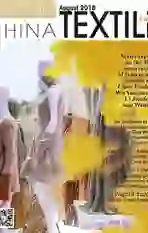Dear readers
2018-10-11
Despite the trade flame that the unilateralist is fanning, the textile players in China are resorting to multilateral channels to ease the conflict heat, actively seeking more opportunities for investment and trade that include future offshore operations. In August and September, China National Textile and Apparel Council is organizing two large investors delegation to visit Kazakhstan and Uzbekistan, the next-door neighbors, and Ethiopia, Zimbabwe, Madagascar and Kenya , the African countries, along the Belt and Road chart that sets Chinas new strategy to revive and prosper the economies on the ancient Silk Road.
Textile industry has been a mainstay sector in the national economy in China, playing an important role in fighting poverty, providing jobs, driving economic dynamics, flourishing domestic and international market supplies, giving impetus to the development of the relevant industries. China is already the largest textile consumer, exporter and producer, and more significantly the largest importer in terms of the single market that supports the worldwide production of the global brands that enjoy a continuously prosperous investment returns in China.
Driven by the Belt & Road Initiative Strategy, and also by the rising cost of local productive factors as well as by the demand for a more efficient and quick-responsive supply chain, our textile industry is more and more regionalized on global basis to invest offshore operations wherever fit and proper, with African countries more favored as can be seen in the investment trend over the last few years. Statistics show that last year witnessed 1.18 billion dollars of investment in textile and apparel installations overseas.
Besides West Asia, the African continent is also well renowned for its abundant acreage of growing cotton, its cotton farmers are natural partners with Chinese yarn spinners that stand out as the world largest spindles operators. But why is Madagascar included in the visiting program ? We know this world fifth largest Island has meager textile raw material resources, where the most important and proficient agro-product is vanilla, one of the best export earnings for the country, but not the cotton.
On a constant lookout, Madagascar is one of the dynamic economies in Africa with its GDP growth by 4.2 percent, a record high after its political crisis during 2008 - 2013, and is privileged with Africa Growth and Opportunity Act (AGOA) that has encouraged textile and apparel booms along with other local governmental incentive policies to welcome more FDI to boost local economy and employment. The delegation is composed of important executives both from national industrial organization and from some important companies who are interested in more contacts to understand the local trade and investment policies for decision-making considerations in corporate strategy. The delegation is here in Africa with the annual conference (in Kenya) of International Textile Manufacturers Federation (ITMF), the global textile body to promote textile and apparel economy by partnering with stake holders in the vertically-integrated industry chain from farm to fashion, and after the conference, 80-person delegation from China is divided into four groups to visit different destinations on the African continent, and we are here with Madagascar with our great pride and pleasure in understanding more of this island to channel Chinese investment to the local economy to grow together in the course of the local governments policy of fostering economic recovery.
Editor-in-Chief
August, 2018
杂志排行
China Textile的其它文章
- Beyond Millennials:Understanding always-on Gen Z consumers
- Layout of industrial intelligent transformation and upgrading in Ningbo Haishu District
- Comparison of Ningbo Youngor Group & The E·Land Group
- CHTC FONG’S:Conquering global customers with international quality
- Rieter: Sales increase in the first half of 2018
- Yarn strength measurement–and protection against quality claims
